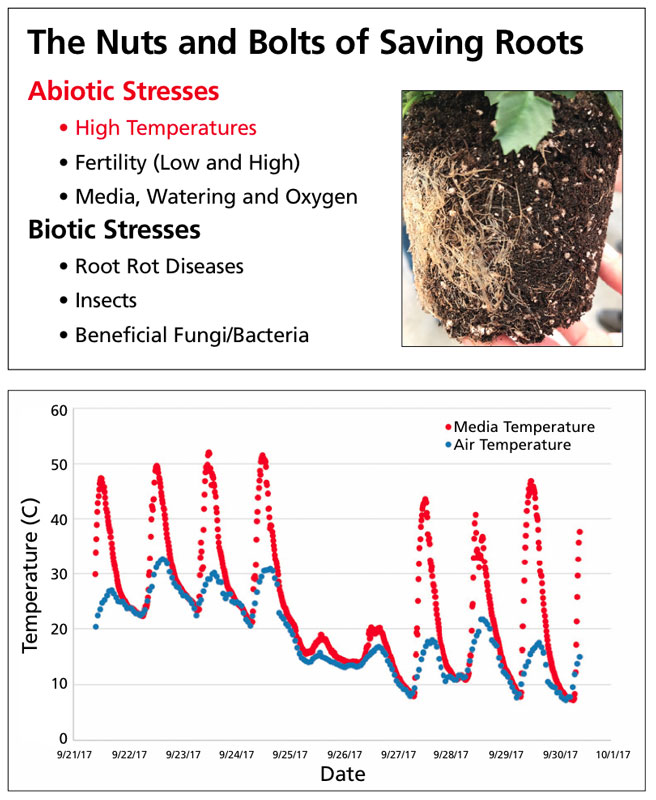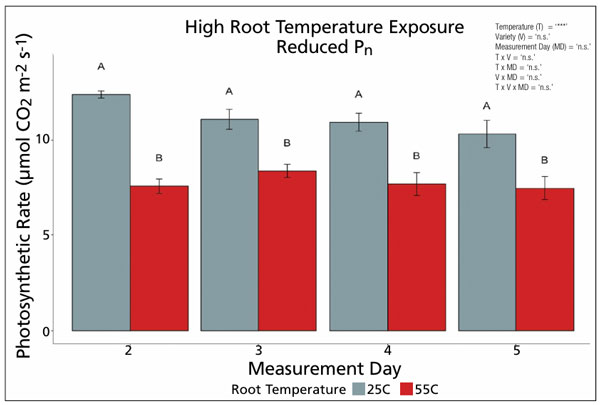11/1/2021
The Importance of Soil Temperature
John Erwin & George Guenthner

Above-ground plant growth can be limited when roots die from root rots or high media soluble salts (personal observation). A less-recognized limiter of above-ground plant growth is high media temperature. Nearly all bedding, potted, perennial and nursery crops are grown in above-ground black or green plastic pots. Those pots can often get quite hot in the sun, thus increasing media and root temperature.
Figure 1. Heating of the south side of a pot (right side of photograph) suppresses or kills roots of Campanula isophylla (air temperature = 65 to 80F [18 to 27C] in April in Half Moon Bay, California).
Does this pot, media and root heating affect plant growth? Many of us have observed that root losses occur at certain times of the year (generally April to October) on the “southside” of pots, first suggesting sun-heating may be involved (Figure 1). These root losses can happen at surprisingly low air temperatures (see below).
Figure 2. Comparison of air (blue) versus media (red) temperature (1 to 2 in. from edge of a 2-gal. pot) in September in St. Paul, Minnesota, over nine days. Note when air temperature varied from 68F (20C) to 91F (33C), media temperature varied from 68F (20C) to 126F (52C).
Our observations led George Guenthner (former Graduate Research Assistant) and me to study how media temperature affected root survival and above-ground leaf photosynthesis. We also were interested in whether root sensitivity to temperature was related to above-ground high temperature tolerance in growth and flowering of plants. Lastly, we explored whether media inoculation with high-temperature tolerant microorganisms increased root-heat tolerance.
One of the first things we did when we started this work was to measure how media temperature varied during the day outdoors. We measured media temperature in outdoor-grown bedding and nursery plants in Minnesota and California. Media temperatures were hotter than we expected! For instance, we recorded media temperatures of 126F (52C) 1 to 2 in. from the edge of a 2-gal. pot in the afternoon of an early September day in Minnesota (89F/31C air temperature, Figure 2).
We were just as surprised to find that afternoon media temperature was cooler in Temecula, California, than in St. Paul, Minnesota. We believe this is the case because night temperatures in September in California were cooler than in Minnesota, which slowed day media heating.
As a result of these observations, we designed experiments to better understand how root temperatures seen in containerized production (77 to 140F/25 to 60C) affected root survival and plant growth. We used tomato as a model plant; tomato is considered a warm-temperature-tolerant crop. Plants were grown for 25 days (after germination) until roots covered the exterior surface of the plug cells they were grown in (72-cell tray). Root temperature was then increased for five days to temperatures ranging from 77 to 140F.
Root damage was quantified through pictures, by recording changes in plant respiration (O2 uptake) and by measuring changes in solution soluble salts (EC) of submerged roots (nanopure water), which quantified rupturing of cell membranes signifying cell death. Leaf photosynthesis was also measured at different root temperatures using a LiCor portable photosynthesis meter. (A portion of the results of this work are outlined in this article.)
Media temperature affected root health and survival: Tomato root health decreased as temperature increased from 95 to 122F/35 to 50C (Figure 3). Complete root death occurred at 122F. At 122F, root respiration decreased to 0 and solution EC reached its maximum. A media temperature of 122F was less than the 126F (52C) observed outdoors in September above (Figure 2).
 Root temperature effects on plant leaf photosynthesis: Root temperature also affected above media growth. Tomato plant size decreased as media temperature increased from 95 to 131F (35 to 55C). Remember, although these temperatures seem very hot, they were similar to what media temperatures observed outside in a typical 2-gal. pot in St. Paul, Minnesota, when the air temperature was 89F (32C). We believe that containerized crops experience these hot temperatures routinely in Minnesota, Maryland and in much of the U.S.
Root temperature effects on plant leaf photosynthesis: Root temperature also affected above media growth. Tomato plant size decreased as media temperature increased from 95 to 131F (35 to 55C). Remember, although these temperatures seem very hot, they were similar to what media temperatures observed outside in a typical 2-gal. pot in St. Paul, Minnesota, when the air temperature was 89F (32C). We believe that containerized crops experience these hot temperatures routinely in Minnesota, Maryland and in much of the U.S.
Figure 3. Effect of increasing media temperature from 77F to 140F (21 to 60C) on 25-day-old tomato seedling (Lycopersicum esculentum) root survival after five days.
Root temperature also affected above-ground leaf photosynthesis. For instance, leaf photosynthesis was lower when root temperature was 131F (orange) compared to 77F (blue-grey) when leaf temperature was held at 77F. That reduction in leaf photosynthesis occurred every day that media temperatures were high for the four days tested, i.e., plant leaf photosynthesis didn’t adapt to the high media temperatures during that time.
Implications
What are the implications of these findings? First, we’re likely routinely killing roots in containerized production because of high media temperature. At least with tomato, reducing root (media) temperatures to below 122F, would increase root survival, and possibly, above-ground growth. (Remember different plant species have different optimal root temperatures.) We’re currently studying how media temperature affects root survival of different street tree species, as well as different herbaceous ornamental crop species.
Another conclusion we can draw from this work is that we’re likely over-applying fungicides to our crops, believing that late spring and summer root loss is due to pathogen infection, rather than high temperature-induced death. Fungicides likely help mitigate root losses and help with regrowth, but the root death we often observe at these times may be because of high temperature rather than root pathogens.
 High container/root temperatures are likely reducing above-ground growth (photosynthesis) and lengthening production time. For instance, a 25% reduction in above-ground photosynthesis may be increasing 2-gal. crop time from two to three years.
High container/root temperatures are likely reducing above-ground growth (photosynthesis) and lengthening production time. For instance, a 25% reduction in above-ground photosynthesis may be increasing 2-gal. crop time from two to three years.
Figure 4. Effect of root temperature on tomato leaf photosynthesis with a 77F (25C) leaf temperature. Root temperature was either 131F/55C (orange) or 77F/25C (blue-grey) for four days.
This work is renewing interest in how pot types affect containerized crop production. What’s clear is that any strategy to decrease media temperature below 86F (30C) may increase root growth/survival (at least with tomato). Reflective pots, aerated pots (slits down the side or fiber sides), inserting a black pot into a white pot or placing a pot in an in-ground insert all have great potential to increase root growth.
In the second article in this series, Paul Fisher from the University of Florida will discuss options to proactively avoid this root death with strategies such as a reflective white pot color, pots with slits or fabric to provide evaporative cooling, or insulating with double-layered or pot-in-pot systems. GT
Acknowledgements: The authors wish to acknowledge the Floriculture Research Alliance grower partners that support University of Maryland research, including Altman Plants, Rocket Farms, Smith Gardens and Wagner’s Greenhouse. This research was also funded in part by a “Resilient Plants” grant from the USDA-Floriculture and Nursery Research initiative, which is supported by SAF-AFE and the Horticulture Research Institute (HRI). We would also like to acknowledge both the University of Minnesota and the University of Maryland Agriculture Experiment Stations. The authors also note that this research was conducted while at the University of Minnesota.
John Erwin is with the Department of Plant Science and Landscape Architecture at the University of Maryland-College Park. George Guenthner is a past Graduate Research Assistant in the Department of Horticulture at the University of Minnesota, who’s currently employed at the Atlanta Botanical Garden. www.psla.umd.edu; www.plantgrower.org